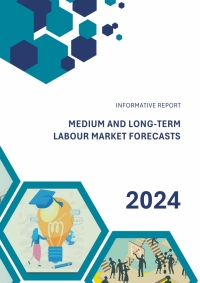The Report outlines the current situation in the labour market and includes the Ministry of Economics updated labour market forecasts for medium-term period up to 2030 and long-term period up to 2040. The labour market forecasts are based on the economic development and demographic scenarios developed by the Ministry of Economics.
Labour market forecasts drafted by the Ministry of Economics are one of the tools that allow an early anticipation of labour market mismatches in the future. They show possible trends in the labour market development and possible risks if the current education system and education supply structure are retained.
Forecasts are one of the stages in the labour supply adjustment process. They are the quantitative basis for further discussions among employment, education and structural policy makers, social partners, scientists and other stakeholders, in order to prepare and adapt the expected structural changes in the national economy in a timely manner.
In 2017, 5.6 thousand people, or 0.6% of employed, were working in chemical and pharmaceutical industry.
Since 2010, the number of employed in chemical and pharmaceutical industry has increased by 0.9 thousand. Most of them were employed in the manufacture of pharmaceutical preparations and the manufacture of soap and detergents, cleaning and polishing preparations, perfumes and toilet preparations.
Although the unemployment rate in chemical and pharmaceutical industry is below the national average, significant labour force shortages cannot be observed. At the same time, problems with attracting appropriately qualified specialists, especially chemical products plant and machine operators, physicists and astronomers, may be faced by certain occupational groups in chemical and pharmaceutical industry.
Overall, more than 3,000 new workplaces in the chemical and pharmaceutical industry could be created by 2035, almost half of which will come from the manufacture of basic pharmaceutical products and pharmaceutical preparations. Approximately ¼ of the total growth in chemical and pharmaceutical industry could occur in specialized industry occupations.
In the medium-term, labour force demand will exceed labour force supply among chemical products plant and machine operators, chemical processing plant controllers, chemical and physical science technicians, chemists, and physicists and astronomers.
More than 5 thousand people, or 0.6% of employed in the economy, are working in E&E.
Since 2010, the number of employed in E&E has increased by 1.5 times – by more than 1,700 employees (almost 2/3 of them were employed in the manufacture of wiring and wiring devices and the manufacture of electronic components and boards).
The registered unemployment rate in E&E occupations is almost half the national average. Insufficiency of labour force can be observed among the electrical engineers, electrical engineering technicians, and electronics mechanics and servicers.
By 2035 the number of workplaces in E&E could increase by 1.9 thousand. The largest growth in the number of workplaces in E&E is expected in the manufacture of electronic components and boards, the manufacture of wiring and wiring devices, and the manufacture of communication equipment. Almost half of the total growth in the number of workplaces in E&E could occur in specialized E&E occupations.
In the medium-term, labour force shortages will remain among electrical engineers, electronics engineering technicians, and electronics mechanics and servicers.



